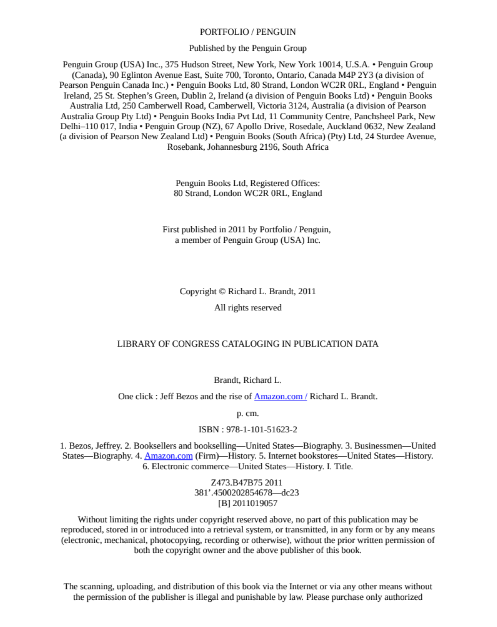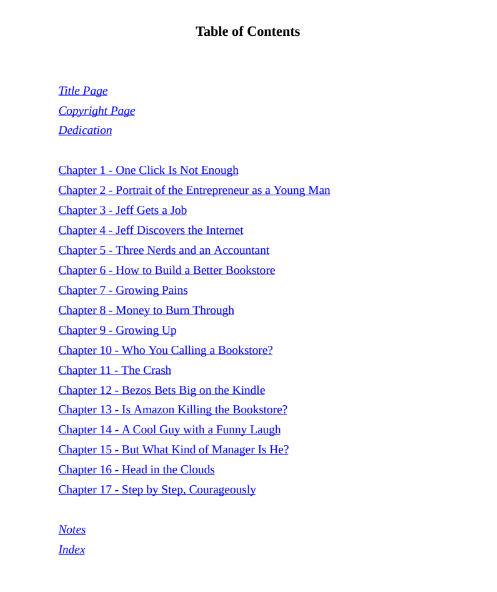


On September 22, 1994, two months after incorporating Amazon.com and ten months before launching the company, Jeff Bezos decided to learn how to sell books. So he took a course on how to start a bookstore, sponsored by the American Booksellers Association. Some forty to fifty aspiring booksellers, from young people starting out to retired couples thinking about a second career, attended the four-day course at the Benson Hotel in Portland. They sat through courses on topics such as bookstore financial operations, customer service, and handling inventory.
One of the instructors was Richard Howorth, owner of Square Books in Oxford, Mississippi. Howorth is a fanatic about customer service (which happens to be the only way to compete with Amazon.com and the chain stores to this day). To emphasize the importance of service, he related the story of his most extreme example of taking care of a customer. One of the store’s managers walked into Howorth’s upstairs office to tell him a customer had a complaint. Howorth strolled downstairs to find out what the problem was. The customer angrily told him that she had parked her car in front of the store, and dirt from potted plants on the store’s balcony had somehow fallen on her car. So Howorth offered to wash her car for her. They climbed into her car and drove to a service station with a car wash.
But the service station was closed for repairs. She became more irate. Howorth then suggested they drive to his house, where he collected a bucket, soap, and a hose and washed the car himself. As she drove him back to the store, her attitude changed. She became downright pleasant. In fact, she came back to the store later that afternoon and bought a bunch of books. Bezos later told an executive at the American Booksellers Association that he was impressed with the story and was determined to make customer service “the cornerstone of Amazon.com.” Bezos considered it his most important weapon. “We know that if we can keep our competitors focused on us, while we stay focused on the customer, that ultimately we’ll turn out all right,” he has said. Interestingly, Jeff’s idea of customer service is different than that held by Howorth, who says personal, face-to-face service with the customer is what’s most important. In the Internet game, customer service is mostly done by unemotional computers. “I’ll bet he hasn’t washed a customer’s car,” Howorth says of Bezos, perhaps with just a touch of bitterness.
In fact, for all his professed dedication to serving the customer, Bezos’s obsession seems to be restricted to building an incredible Web site and to making sure deliveries arrive when promised. It’s hard to even find a customer service number on Amazon.com. Bezos wants everything to be done via email. Amazon’s customer service started with Bezos himself answering the emails, and by 1999 was manned by five hundred of these “customer care” representatives packed into cubicles and tied to their telephones and email accounts to answer questions from customers. The people handling these emails are generally overqualified, underpaid people with no experience in bookselling.
From the beginning, disaffected academics were popular because they were well-read and could supposedly help find books on a huge variety of topics. They were paid about $10 to $13 an hour, but with the potential of promotions and stock options dangled before their glazed eyes. Not everyone found Nirvana in this environment. Richard Howard, for example, has a master’s degree in literature but decided to take the entry-level customer care job at Amazon in 1998 with hopes of moving into Editorial, where he could write reviews of books. What he found was a work mill with four “Customer Service Tier 1 E-Mail Representatives” to a cubicle. Supervisors listened in on calls to monitor performance, and rated the workers by how many emails or phone calls they could answer per minute. Howard chronicled his experience for a Seattle newspaper in an article titled “How I ‘Escaped’ from Amazon.cult.”
When Howard got a call from a customer one day asking how to find a copy of James Michener’s Centennial because the customer was interested in Civil War–era fiction, Howard suggested Gore Vidal’s Lincoln as a better alternative—just the type of thing a knowledgeable employee in a good bookstore might do. Howard spent three or four minutes on the call, he said, and was reprimanded by his supervisor. After three and a half weeks on the job he was fired for not being productive enough. He took a contract job at Microsoft instead.
What the starry-eyed customer service representatives with visions of huge stock options found when starting their jobs at Amazon was long hours and options for just one hundred Amazon shares, as long as they performed well for three years. The best could answer a dozen emails a minute. Those who dropped below seven were often fired. The Washington Post did an exposé of this “dark” side of Amazon and quoted one customer service rep as saying, “We’re supposed to care deeply about customers, provided we can care deeply about them at an incredible rate of speed.”
The customer service reps also had to learn the UNIX software system the company used, and had to take a three-week training course at Amazon to learn how everything worked, including how orders for books were submitted, how they were delivered to the warehouse, how they were shelved, how to match orders to the packed books, and how to choose the best shipping method. The most frequent questions came from people who needed help ordering a book on the site or wanted to know where the book they had ordered was. But Bezos knew he would never be able to offer the kind of service one gets from a physical store staffed by human helpers. “We’re never going to have sofas; we’re never going to have lattes,” he told BusinessWeek magazine in June 1997.
Where Bezos really managed to shine was in creating a great online experience with very little human interaction with customers. The site had to be simple, fast, and intuitive. It had to offer an unprecedented number of books at the cheapest price possible and deliver them quickly. The whole thing just had to work without problems so that people left the site happy. That seems to be enough for most people. “When we do make a customer unhappy at some point,” Bezos was later to explain, “these people come out of the woodwork and say, ‘Well, actually that wasn’t my experience.’ Word- of-mouth is very powerful.”


